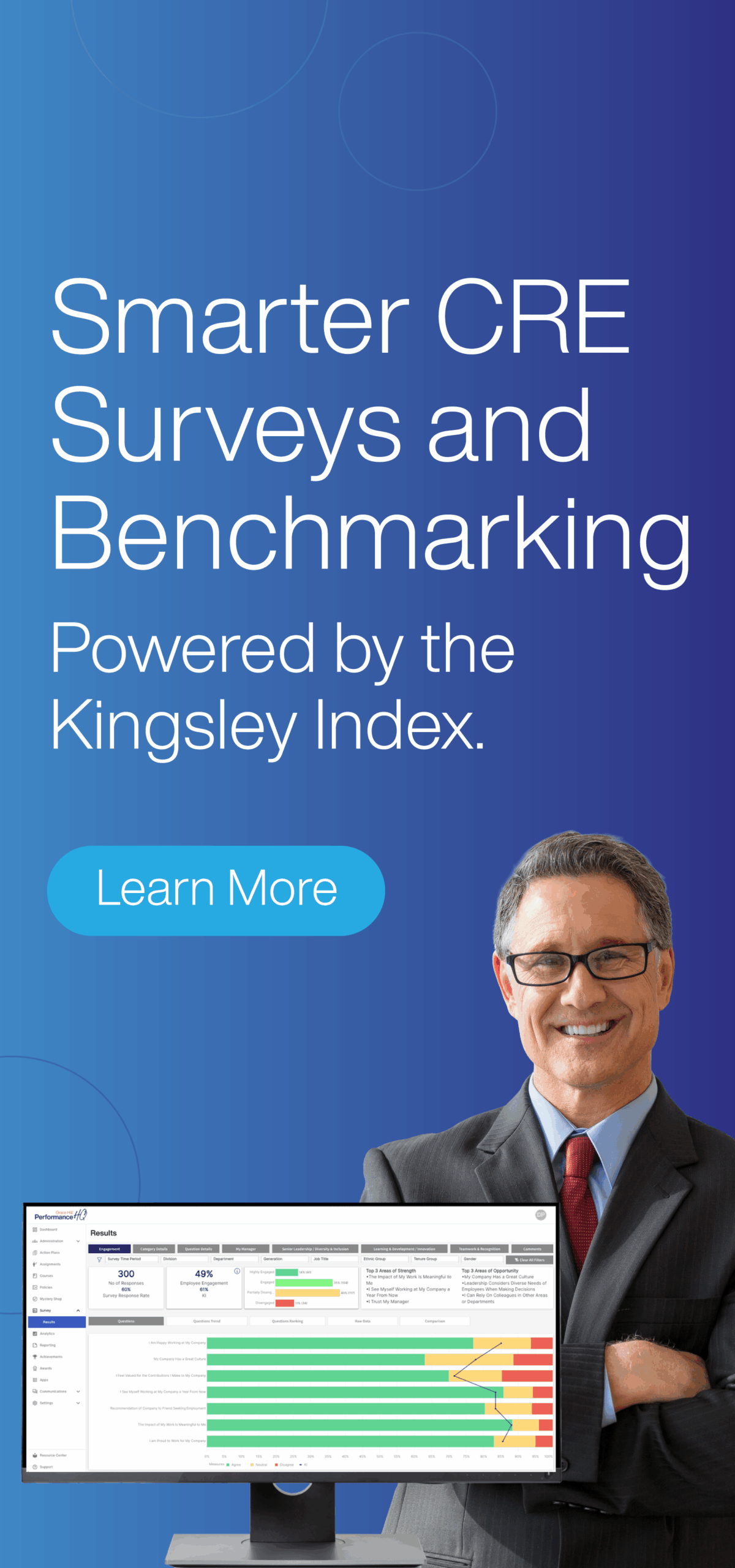Tenant satisfaction isn’t just a checkbox — it’s a cornerstone for attracting new tenants and retaining current ones, which in turn strengthens the property’s performance and value. However, knowing where to start can be challenging.
Tenant surveys are one of the most effective ways to pinpoint what’s working and where improvements are needed. Tailored surveys provide actionable insights, enabling property owners to address shortcomings and prioritize smart investments in areas that matter most to tenants.
Happy tenants are more likely to renew, creating stability and increasing asset value. But it’s important to note that impactful strategic improvements in CRE extend beyond cosmetic upgrades. With tenant priorities guiding decision-making, this blog explores six powerful strategies property owners should consider to create lasting value and drive portfolio performance.
6 Commercial Real Estate Strategies for Driving Value and Portfolio Performance
- Sustainability Initiatives and Energy Efficiency
- Flexible Lease and Space Options
- Enhanced Tenant Amenities and Shared Spaces
- Smart Building Technology
- Improved Tenant Communication and Engagement
- Health and Wellness Features
- How To Know Which Upgrades Are Right for Your Property
1. Sustainability Initiatives and Energy Efficiency
Adopting green building practices is a powerful way for property owners to cut operational costs while attracting eco-conscious tenants. With utility costs consistently rising due to increased energy demand and market instability, Environmental, Social & Governance (ESG) priorities are growing in importance. Many businesses prioritize reducing their carbon footprint today, so having a LEED certification or other sustainability credentials can set a property apart in competitive markets.
Because of this, some property managers are making upgrades that highlight their commitment to sustainability and ESG. Prioritizing energy-efficient upgrades allows tenants to reduce their utility bills, which adds direct value to their experience. For commercial organizations, conducting third-party surveys can increase your GRESB score and give insight into what sustainability initiatives matter most to your tenants.
These can be large- or small-scale solutions, but they can make a significant impact. Some examples of this might include:
- Advanced HVAC systems
- Double-paned windows
- Energy-saving window treatments
- Additional insulation
- Motion-detecting lights
- Low-flow aerators
- LED lighting
In some cases, property owners may even qualify for tax credits on specific energy-efficient improvements. Consulting local energy providers or government programs can provide valuable insights into available incentives and potential cost savings.
The important thing to understand, though, is that ESG initiatives provide a significant benefit to CRE owners and aren’t simply government mandates. In fact, the primary drivers of ESG reporting come from the industry itself, and these voluntary efforts are widely adopted throughout the real estate sector primarily due to competitive market pressures from socially-conscious tenants, clients, and investors.
Regardless, the benefits of incorporating ESG initiatives can’t be overlooked because they help CRE property owners:
- Differentiate your portfolio.
- Understand stakeholder priorities.
- Prioritize investments.
- Increase asset value.
By implementing sustainability initiatives and prioritizing energy efficiency, commercial real estate property owners not only meet growing ESG expectations but also position themselves as leaders in a competitive, eco-conscious market. Embracing these changes can enhance property value, attract mindful tenants, and create long-term savings, making sustainability a smart investment for the future.
2. Flexible Lease and Space Options
The commercial real estate market is dynamic, and offering flexible space configurations and adaptable lease terms can be a game changer. By creating adjustable layouts or adding coworking areas, property owners empower tenants to scale up or down as their business needs evolve. This approach not only enhances tenant retention but also attracts a diverse range of businesses that value versatility.
Maximizing vacant space with flex office setups or month-to-month lease options can provide a steady income stream and make the property more appealing to prospective tenants. Flexible lease terms are desirable to tenants looking for contract options that align with their unique operational needs.
By making flexibility a key factor, property owners position themselves to increase tenant satisfaction and improve tenant retention rates.
3. Enhanced Tenant Amenities and Shared Spaces
Enhancing tenant amenities and shared spaces is a strategic investment that can significantly boost a property’s value and drive long-term portfolio performance. Studies predict that by 2025, CRE properties that incorporate a diverse roster of amenities will experience 12% higher demand from tenants versus their plain commodity counterparts. The truth is modern tenants seek more than office space — they value a sense of community and convenience.
As tenant expectations evolve, offering amenities such as fitness centers, coworking areas, rooftop lounges, and social gathering spaces has become essential to remaining competitive. Research shows that “outdoor space is one of the top amenities tenants are searching for, but only 25% say they have access to fresh air in their offices,” making this an area of focus for many CRE property owners.
Other amenities like bike storage, childcare options, or pet-friendly facilities can further differentiate a property, making it more attractive to current and potential tenants. These amenities attract high-quality tenants and encourage longer leases by fostering a sense of community and convenience.
Additional ideas for re-imagining spaces include:
- Converting vacant spaces into shared conference or training rooms.
- Turning basements into shared exercise facilities.
- Revamping an unused area for a childcare center for employees who work onsite.
Well-maintained amenities contribute to a positive tenant experience, which reduces turnover and the costs associated with frequent re-leasing. Ultimately, by prioritizing shared spaces and amenities, property owners can build a lasting brand reputation, strengthen tenant loyalty, and establish a competitive edge in the market.
With so many options, how do you know which is best for your specific tenants? It requires intentionality. A well-planned engagement survey can give you the insight you need to make key amenity investment decisions that deliver the experiences your tenants crave.
Looking for more data on amenities? Access this exclusive report analyzing tenant amenity preferences!
4. Smart Building Technology
Investing in smart building technology offers property owners a compelling path to enhance portfolio value and improve long-term performance. Smart technology optimizes building operations through automation and data-driven insights, enabling properties to run more efficiently and with lower operating costs.
For instance, smart HVAC systems use real-time occupancy data to adjust heating and cooling, reducing energy consumption and, consequently, utility expenses. These savings not only boost net operating income (NOI) but also increase property appeal as tenants and buyers increasingly prioritize sustainable, energy-efficient buildings.
Moreover, smart building technology strengthens tenant satisfaction and retention, which directly impacts occupancy rates and revenue. Features like app-based access controls, digital work orders, and automated lighting systems contribute to a more convenient and comfortable tenant experience, fostering loyalty and reducing turnover.
Smart technology also supports predictive maintenance, helping property managers address issues before they disrupt tenants or escalate into costly repairs. These advancements position smart buildings as modern, desirable spaces, increasing their market value and future-proofing portfolios in an increasingly tech-focused real estate market.
5. Improved Tenant Communication and Engagement
Regular communication and transparent engagement with tenants foster a positive relationship that goes beyond the lease agreement, directly impacting tenant retention rates and overall satisfaction. By encouraging open lines of communication, property owners can address tenant needs swiftly and reduce turnover, decreasing vacancy periods and associated leasing costs.
Engaged tenants are more likely to take pride in their living spaces, maintain them well, and stay for longer lease terms. This reduces the financial drain of frequent tenant turnover and strengthens a property’s overall stability and appeal. The conversation cannot start at lease renewal time. Creating a feedback loop, such as regular satisfaction surveys, can also help owners stay aligned with evolving tenant needs and preferences and promptly (and proactively) address issues.
Beyond retention, consistent communication and engagement build trust, which can improve a property’s reputation and attract high-quality tenants. When tenants feel heard and valued, they are more likely to recommend the property to others, contributing to a strong, community-oriented environment that enhances the property’s appeal.
This reputation boost can result in higher occupancy rates, enabling owners to set competitive rental rates that drive revenue. In this way, tenant engagement not only creates a better living experience but also becomes a proactive strategy for improving asset performance, reducing costs, and maximizing long-term investment returns.
6. Health and Wellness Features
Investing in health and wellness upgrades is a highly effective strategy for property owners aiming to boost portfolio performance and long-term value. In recent years, the demand for spaces that support healthy lifestyles has surged as tenants increasingly prioritize physical and mental well-being. In fact, according to JLL’s Regenerative Workplace Report, “One-third of the workforce does not have access to any amenities supporting their health and wellbeing—and they’re craving it.”
Especially in office and mixed-use spaces, tenants appreciate wellness-oriented improvements, like enhanced air filtration systems, access to natural light, green spaces, and ergonomic workspace designs. These types of upgrades not only create healthier environments but also reduce energy costs, enhance tenant satisfaction, and improve retention rates.
Studies show tenants are more likely to stay in and recommend properties that prioritize wellness, which translates into reduced turnover and increased occupancy — key factors that drive revenue growth and maximize portfolio performance.
Properties with wellness-focused features appeal to a broader audience, including individuals and businesses keen on aligning with spaces that support sustainable and healthy living. Wellness-oriented buildings often achieve premium pricing and lower vacancy rates, especially as wellness continues to play an integral role in tenant decision-making.
Investing in wellness features adds lasting value to a property and contributes to long-term portfolio performance. Health-focused amenities align with Environmental, Social, and Governance (ESG) initiatives, attracting institutional investors who prioritize sustainability and wellness. They can also lead to energy savings, reduced maintenance costs, and healthier indoor environments, all of which support operational efficiency.
By focusing on these tenant-centric strategies, property owners can make improvements that do more than enhance physical appeal; they create a functional, sustainable, and flexible space that promotes tenant retention, attracts high-quality occupants, and drives long-term asset value.
How To Know Which Upgrades Are Right for Your Commercial Real Estate Property
Making improvements and investments is key to a successful property. However, to know which upgrades will create the most value, the bottom line is this: Start with a survey. Resources are limited, and decisions shouldn’t be made without measured and reliable data that help you determine what amenities and features your tenants actually want.
Strategic commercial real estate improvements are more than just property upgrades; they’re an investment in tenant retention and asset performance. But without understanding your tenants’ perceptions, it is difficult to know where to focus your time, resources, and investment.
KingsleySurveys can help you make data-driven decisions. For nearly 35 years, KingsleySurveys has been a trusted partner to the world’s leading CRE organizations.
How Grace Hill’s KingsleySurveys solution helps you create lasting value:
- It helps raise your ESG standards and GRESB score: Your ESG standards highlight your organization’s commitment to ongoing sustainability objectives. Responding to tenant sustainability priorities with a third-party survey can improve tenant satisfaction and increase your GRESB score.
- It provides access to The Kingsley Index™: The Kingsley Index is the most comprehensive industry database and allows comparative analysis of survey data to specific benchmarks for the office, industrial, medical, and retail sectors. By comparing your results to the Kingsley Index, you can earn Kingsley Excellence Award recognition for outstanding performance that helps you stand out from the competition. CRE executives who understand true tenant satisfaction will increase renewals, attract new tenants, and build asset value.
- It offers robust and customized reporting: KingsleySurveys includes a robust reporting engine with visual dashboards and analysis from Grace Hill experts. We help summarize customer survey results to translate critical performance data into actionable insights for you and your team.
Making the right upgrades means focusing on what your tenants truly value. By leveraging insights from Grace Hill’s KingsleySurveys, you can make informed, strategic decisions that align with tenant needs and preferences while supporting your property’s ESG and GRESB goals.
With access to industry benchmarks and actionable data from customized reporting, you’re equipped to implement improvements that not only boost tenant satisfaction but also enhance your property’s market appeal and long-term performance.
Investing in tenant-focused upgrades doesn’t just elevate your property; it creates a lasting competitive edge in an evolving commercial real estate landscape.
When making impactful upgrades and financial property investments, you have a choice: comprehensive survey tools that capture actionable data or gut instinct. Which will you choose?
KingsleySurveys is the industry’s trusted solution for delivering actionable insight. Isn’t it time to stop making decisions in the dark? Contact Grace Hill today to learn how our tenant surveys can improve your portfolio performance.


 Customer Support
Customer Support




